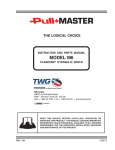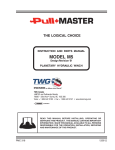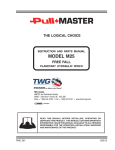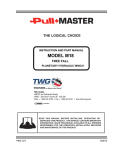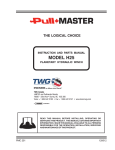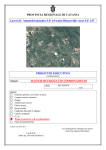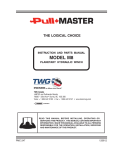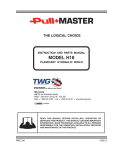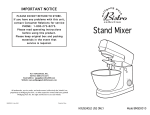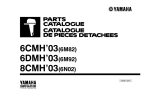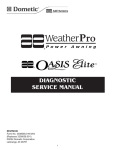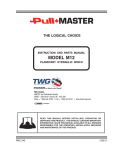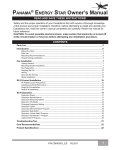Download Model R5 Service Manual
Transcript
THE LOGICAL CHOICE INSTRUCTION AND PARTS MANUAL MODEL R5 PLANETARY HYDRAULIC WINCH TWG Canada LANTEC and Pullmaster Brands 19350 – 22nd Ave • Surrey, BC V3S 3S6 Voice: + 1 604-547-2100 • Fax: + 1 604-547-2147 • www.team-twg.com READ THIS MANUAL BEFORE INSTALLING, OPERATING OR SERVICING THIS PRODUCT. THIS MANUAL CONTAINS IMPORTANT INFORMATION. MAKE THIS MANUAL AVAILABLE TO ALL PERSONS RESPONSIBLE FOR THE OPERATION, INSTALLATION, SERVICING AND MAINTENANCE OF THIS PRODUCT. PMC 172 120612 Effective 2011/10/01 SUPERSEDES ALL PRIOR WARRANTIES LIMITED WARR ANTY 50130-0 Seller warrants that each article (whether Gear Drive Products, Brake Products and/or Winch Products, all of which are covered hereunder) sold under this order shall at the time of shipment (i) conform to applicable specifications, and (ii) be free from defects in material and workmanship during normal and ordinary use and service (the "Warranty"). Buyer's exclusive remedy and Seller's sole obligation under this Warranty shall be, at Seller's option, to repair or replace any article or part thereof which has proven to be defective, or to refund the purchase price of such article or part thereof. Buyer acknowledges that Buyer is knowledgeable concerning the articles covered by this Warranty and sold in connection therewith which are being purchased, that Buyer has reviewed this Warranty and that the remedies provided hereunder are adequate and acceptable to Buyer. This Warranty shall expire one (1) year from the date the article is first shipped by Seller. Notice of claimed breach of this Warranty must be given by Buyer to Seller within the applicable period. Such notice shall include an explanation of the claimed warranty defect and proof of date of purchase of the article or part thereof for which warranty coverage is sought. No allowances shall be made by Seller for any transportation, labor charges, parts, "in and out" costs, adjustments or repairs, or any other work, unless such items are authorized in writing and in advance by Seller. Nor shall Seller have any obligation to repair or replace items which by their nature are expendable. If an article is claimed to be defective in material or workmanship, or not to conform to the applicable specifications, Seller will either examine the article at Buyer's site or issue shipping instructions for return to Seller. This Warranty shall not extend to any articles or parts thereof which have been installed, used, or serviced otherwise than in conformity with Seller's applicable specifications, manuals, bulletins, or instructions, or which shall have been subjected to improper installation, operation, or usage, misapplication, neglect, incorrect installation, overloading, or employment for other than normal and ordinary use and service. This Warranty shall not apply to any article which has been repaired, altered or disassembled, or assembled by personnel other than those of Seller. This Warranty shall not apply to any article upon which repairs or alterations have been made (unless authorized in writing and in advance by Seller). This Warranty shall not apply to any articles or parts thereof furnished by Seller to Buyer's specifications and/or furnished by Buyer or acquired from others at Buyer's request. SELLER MAKES NO EXPRESS WARRANTIES AND NO IMPLIED WARRANTIES OF ANY KIND, OTHER THAN THE WARRANTY EXPRESSLY SET FORTH ABOVE. SUCH WARRANTY IS EXCLUSIVE AND IS MADE AND ACCEPTED IN LIEU OF ANY AND ALL OTHER WARRANTIES, EXPRESS OR IMPLIED, INCLUDING WITHOUT LIMITATION THE IMPLIED WARRANTIES OF MERCHANTABILITY AND FITNESS FOR A PARTICULAR PURPOSE. Buyer expressly agrees that Seller is not responsible to perform any work or investigation related in any way to torsional vibration issues and is not responsible for the detection or remedy of Natural Frequency Vibration of the mechanical system in which the unit is installed. Buyer acknowledges, understands and agrees that this Warranty does not cover failures of the unit which result in any manner from the operation of the machine or unit at vibration frequencies at or near the natural frequency vibration of the machine in such a way that damage may result. Buyer expressly agrees that Seller is not responsible for failure damage or accelerated wear caused by machine or ambient vibration. Further, Buyer acknowledges and agrees that Buyer is always solely responsible for determination and final approval of the “application factor” which may be used in Seller’s calculations and this application factor is 1.0 unless otherwise stated in Seller’s quotation specifications. The remedies for this Warranty shall be only those expressly set forth above, to the exclusion of any and all other remedies of whatsoever kind. The limited remedies set forth above shall be deemed exclusive, even though they may fail their essential purpose. No agreement varying or extending the foregoing Warranty, remedies, exclusions, or limitations shall be effective unless in writing signed by an executive officer of Seller and Buyer. This Warranty is non-transferable. If a party who had purchased articles from Buyer, or from persons in privity with Buyer, brings any action or proceeding against Seller for remedies other than those set forth in this Warranty, Buyer agrees to defend Seller against the claims asserted in such action or proceeding at Buyer’s expense, including the payment of attorneys’ fees and costs, and indemnify Seller and hold Seller harmless of, from and against all such claims, actions, proceedings or judgments therein. Buyer also agrees to defend and indemnify Seller of, from and against any loss, cost, damage, claim, debt or expenses, including attorneys’ fees, resulting from any claims by Buyer or third parties to property or injury to persons resulting from faulty installation, repair or modification of the article and misuse or negligent operation or use of the article, whether or not such damage to property or injury to persons may be caused by defective material, workmanship, or construction. ADVISORY: Winches and hoists are not approved for lifting or handling personnel or persons unless specifically approved in writing from Seller for the specific intended application. Under no circumstances shall Seller be liable (i) for any damage or loss to any property other than the warranted article or part thereof, or (ii) for any special, indirect, incidental, or consequential damage or loss, even though such expenses, damages, or losses may be foreseeable. The foregoing limitations on Seller's liability in the event of breach of warranty shall also be the absolute limit of Seller's liability in the event of Seller's negligence in manufacture, installation, or otherwise, with regard to the articles covered by this Warranty, and at the expiration of the Warranty period as above stated, all such liabilities shall terminate. Buyer’s purchase of any article(s) covered by this Warranty shall constitute acceptance of the terms and conditions hereof and shall be binding upon Buyer and Buyer’s representatives, heirs and assigns. The laws of the Province of British Columbia shall govern Buyer’s rights and responsibilities in regard to this Warranty and the transaction(s) subject thereto, and the Province of British Columbia shall be the exclusive forum and jurisdiction for any action or proceedings brought by Buyer in connection herewith or any dispute hereunder. If any of the terms and conditions contained within this Warranty are void, the remaining provisions thereof are and shall remain valid and enforceable. SAFETY RECOMMENDATIONS Definition: Caution indicates a potentially hazardous situation which, if not avoided may result in minor or moderate injury. DANGER FAILURE TO COMPLY WITH THE FOLLOWING SAFETY RECOMMENDATIONS AND LOCAL RULES AND REGULATIONS WILL RESULT IN PROPERTY DAMAGE, SEVERE INJURY OR DEATH. Definition: Warning indicates a potentially hazardous situation which, if not avoided could result in death or serious injury. Definition: Danger indicates a potentially hazardous situation which, if not avoided will result in death or serious injury. The planetary hydraulic winches are made for hoisting and lowering loads and to be operated by trained and professional personnel. They are not designed for operations involving lifting or moving personnel. The winches are powered by hydraulic power. The ropes / cables for hoisting operations are not supplied by PULLMASTER. The winches are always assembled in an application, they do not function as an independent machine and it is not allowed to use them as such. The winches are to be used within the specifications as listed in the manual under “SPECIFICATIONS”. Other use as foreseen in the functional description of the hydraulic winch is not allowed without written permission from PULLMASTER. 1. Do not install, operate or service winch before reading and understanding manufacturer's instructions. 2. The winch described herein is not designed for operations involving lifting or moving personnel. 3. Do not lift or carry loads over people. 18. Use only recommended hydraulic oil and gear lubricant. 19. Keep hydraulic system clean and free from contamination at all times. 20. Maintain winch and equipment in good operating condition. Perform scheduled maintenance regularly. 4. Do not exceed recommended operating pressure 21. Keep hands clear when winding wire rope onto (psi) and operating volume (gpm). the winch drum. 5. Do not jerk the winch. Always smoothly accelerate and decelerate load. 22. Do not use the wire rope as a ground for welding. 6. Do not operate a damaged, noisy or malfunctioning winch. 23. Rig the winch carefully. Ensure that the wire rope is properly anchored to the correct cable anchor slot at the cable drum. 7. Do not leave a load suspended for any extended period of time. 24. Do not lift a load with a twisted, kinked or damaged wire rope. 8. 25. Consult wire rope manufacturer for size, type and maintenance of wire rope.elen Never leave a suspended load unattended. 9. Winch should be maintained and operated by qualified personnel. 10. Inspect winch, rigging, mounting bolts and hoses before each shift. 11. Warm-up equipment before operating winch, particularly at low ambient temperatures. 12. Verify winch function by raising and lowering a full test load to a safe height before each shift. 13. Do not weld any part of the winch. 14. Verify gear lubrication and brake circulation supply and return before operating winch. 15. Be sure of equipment stability before operating winch. 16. Wear proper clothing to avoid entanglement in rotating machinery. 17. 26. Maintain five wraps of wire rope on the cable drum at all times. 27. In case of a power failure or breakdown leading to an unexpected stop of the hydraulic power circuit, stand clear of the area and the load being hoisted, take the necessary precautions to prevent access to area where the load is halted. 28. The noise level of the winch is 83 dBA measured on a distance of 1.00 meter, 1.60 meters high. The measuring equipment used was: Realistic #42-3019. 29. Clean up any oil spillage immediately. 30. Wear proper clothing and personal protection equipment such as, footwear, safety goggles and a hard hat. Read manual first. Always stand clear of the load. 172 REV.051117 PAGE 1 DESCRIPTION OF THE MODEL R5 GENERAL DESCRIPTION: The PULLMASTER Model R5 is a planetary, hydraulic winch primarily intended for mobile or recovery adaptations. The winch has equal speed in both directions and a freespool feature which can be operated manually or hydraulically, depending on the option. The main components of this unit are: ✛ ✛ ✛ ✛ ✛ ✛ ✛ high torque, low speed hydraulic motor multi-disc brake with over-running clutch planetary reduction brake housing cable drum final drive housing freespool mechanism FUNCTION IN FORWARD ROTATION (PULLING): In forward rotation, or when the winch is pressurized for pulling, the output torque and rpm of the hydraulic motor are transmitted through the brake shaft and freespool coupling to the final sungear. The planet gears are driven by the final sungear and cause the planet hub to drive the cable drum at a reduction of 9.25:1. When a load is pulled, an over-running clutch which connects the motor drive shaft to the automatic brake assembly, permits free rotation of the sungear, without effecting the brake. When the winch rotation is stopped, the load on the cable drum causes the over-running clutch to lock and the load is held safely by the disc brake. FUNCTION IN REVERSE ROTATION (PAYING OUT): In reverse rotation, or paying out of a load, hydraulic pressure from the reverse side of the hydraulic motor is channelled to the brake piston, causing the brake piston to release the multi-disc brake. The pressure required to release the brake is 400 - 600 psi (28 - 42 bar). The over-running clutch, connecting the motor drive shaft to the brake assembly, locks, causing the brake discs to rotate between stationary divider plates. If the load on the cable drum increases the pay out speed, the resulting pressure drop in the brake piston increases friction between the friction plates and slows the drum. In this way, a completely smooth pay out speed can be achieved in a stepless operation by modulation of the winch control valve. When the control valve is returned to neutral position, rotation stops and the disc brake applies automatically. During pay out operations of the winch, the friction created by the brake discs results in heat. This heat is dissipated by the circulation of hydraulic fluid from the brake housing, supplied internally through the hydraulic motor. This circulation flow is internally vented to the return line through a check valve arrangement inside the specially modified motor. The circulation flow is supplied only when the wire rope is payed out. A separate vent line connecting the PULLMASTER Model R5 with the hydraulic reservoir is not required (see TYPICAL HYDRAULIC CIRCUIT). IMPORTANT: SAFETY VALVE The PULLMASTER Model R5 winch does not require a drain line up to 100 psi permissible back pressure in the brake housing. To indicate excessive pressure and potential damage to the hydraulic motor or to the oil seal in the brake housing, a safety valve is installed on the motor adaptor. BREATHER RELIEF VALVE Excessive pressure in the brake housing will damage the oil seal separating the brake housing from the drum interior. Damage to this seal will cause the drum to fill up with hydraulic fluid. To prevent damage to the drum seal and end cover of the final drive if the cable drum fills up with hydraulic fluid, a breather relief (PARTS REFERENCE item 130) is installed on the end cover. The breather relief does not prevent oil seal failure but serves as an indicator or warning that the seals between brake housing and the cable drum interior have failed and must be replaced immediately. PAGE 2 172 REV.950101 DESCRIPTION OF THE MODEL R5 CONTINUED FUNCTION OF THE FREESPOOL MECHANISM: MODEL R5-12-70-1M This model has a manually actuated freespool function. The freespool feature is enabled by turning the freespool handle 180 degrees in a counterclockwise direction. This will disengage the final sungear from the freespool coupling and provide for a free turning drum. To re-engage the freespool coupling, turn the handle 180 degrees in a clockwise direction. IMPORTANT: The freespool function cannot be engaged or disengaged under load or while the cable drum is rotating. MODEL R5-12-70-1F This model has a hydraulically actuated freespool feature. The final sungear is pulled out of engagement with the freespool coupling, by the freespool piston, which is spring applied and pressure released. To disengage the freespool coupling, hydraulic pressure of 400 psi (28 bar) must be supplied to the freespool release port (see INSTALLATION DRAWING). When the hydraulic pressure is removed, the freespool coupling will re-engage. IMPORTANT: The freespool coupling cannot be engaged or disengaged under load or while the cable drum is rotating. 172 REV.950101 PAGE 3 EXPLANATION OF MODEL CODING R 5 X - XX - XX - X X - X XXXX BASIC UNIT SERIES R = Recovery winch SIZE OF UNIT REDUCTION RATIO Only used for non-standard reduction ratios TYPE OF BRAKE -12 Automatic brake, counterclockwise drum rotation, intravent -15 Automatic brake, clockwise drum rotation, intravent HYDRAULIC MOTOR -70 High torque, low speed hydraulic motor, 12.9 cubic inch displacement (Other displacements are optional) DRUM SIZE -1 5.0 inch drum diameter X 11 3/8 inch flange diameter X 9 inch between flanges - STANDARD (For other drum sizes refer to APPENDIX A) OPTIONS - F Hydraulically actuated freespooling - M Manually actuated freespooling DESIGN REVISION SPECIFICATION NUMBER Describes features not identified by preceding codes NOTE: PAGE 4 Clockwise and counterclockwise drum rotation is the direction of rotation for pulling or hoisting, established by looking at the hydraulic motor. 172 REV.010215 OPTIONS CLOCKWISE ROTATION: The drum rotation of the standard PULLMASTER Model R5 planetary winch is counterclockwise for pulling when looking at the hydraulic motor of the winch. Drum rotation for clockwise hoisting direction is available as an option. CABLE DRUM SIZES: Refer to APPENDIX A for optional cable drum sizes and specifications. OPTIONAL HYDRAULIC GEAR MOTOR: The performance of the standard PULLMASTER Model R5 planetary winch is based on a NICHOLS Series 110 IGR hydraulic motor with a displacement of 12.9 cubic inches. The performance of the winch can be changed by using motors with different displacements. (Contact the factory for performance information if using motors with different displacements.) The PULLMASTER WINCH CORPORATION will consider other options for quantity requirements. 172 REV.950101 PAGE 5 SPECIFICATIONS Performance specifications are based on standard hydraulic motor, gear ratio and cable drum with 1/2 inch diameter wire rope. For other cable drums refer to APPENDIX A. Performance specifications for winches supplied with optional motors are provided in attached supplement. CABLE DRUM DIMENSIONS (STANDARD DRUM): Barrel diameter Flange diameter Barrel length 5.00 in 11.38 in 9.00 in 127 mm 289 mm 229 mm 1394 ft 732 ft 481 ft 337 ft 268 ft 209 ft 160 ft 425 m 223 m 147 m 103 m 82 m 64 m 49 m 2350 psi 162 bar MAXIMUM OPERATING VOLUME: 15 (US) gpm 57 l/min MINIMUM OPERATING VOLUME: 5 (US) gpm 19 l/min DRUM TORQUE AT MAXIMUM PRESSURE: 30,305 lb-in 3,424 Nm CABLE STORAGE CAPACITY: (Size of wire rope) 3/16 in 1/4 in 5/16 in 3/8 in 7/16 in 1/2 in 9/16 in MAXIMUM OPERATING PRESSURE: DRUM RPM AT MAXIMUM VOLUME: 26 rpm LINE PULL AT MAXIMUM PRESSURE: Bare drum Full drum 11,020 lb 5,573 lb 49.0 kN 24.8 kN 37 fpm 74 fpm 11 m/min 23 m/min 100 psi 6.9 bar LINE SPEED AT MAXIMUM VOLUME: Bare drum Full drum PERMISSIBLE SYSTEM BACK PRESSURE AT MOTOR RETURN PORT: LUBRICATING OIL: PAGE 6 Refer to RECOMMENDATIONS for viscosity and instructions. Refer to APPENDIX A for oil volume required. 172 REV.030429 PERFORMANCE GRAPHS PG-R5 LINE PULL VS. OIL PRESSURE: 176 UM 2000 LL UM DR AN DR 141 UM ME FU OIL PRESSURE kg/cm OIL PRESSURE PSI 2500 R ED R BA 1500 105 1000 70 500 35 2 0 0 0 2204 4408 6612 8816 11020 lb. 0 1000 2000 3000 4000 5000 kg. LINE PULL LINE SPEED VS. OIL VOLUME: 57 DR UM UM N EA RE 12 BA M OIL VOLUME LITERS/MIN OIL VOLUME GPM (US) 15 M RU DR D LL 45 FU 9 34 6 23 3 11 0 0 0 16 33 49 66 82 fpm 0 5 10 15 20 25 m/min LINE SPEED Performance graphs are based on standard hydraulic motor and cable drum with 1/2 inch diameter wire rope. 172REV.950101 PAGE 7 TYPICAL HYDRAULIC CIRCUIT R5-M HC-R5-M-C CONTROL VALVE (MOTOR SPOOL) 4-WAY SPRING RETURN TO CENTER PRESSURE RELIEF VALVE FILTER HYDRAULIC PUMP RESERVOIR PAGE 8 172 REV.030429 TYPICAL HYDRAULIC CIRCUIT R5-F HC-R5-F-C 400 PSI (28 BAR) PRESSURE REQUIRED FOR FREESPOOL CONTROL VALVE (MOTOR SPOOL) 4-WAY SPRING RETURN TO CENTER PRESSURE RELIEF VALVE FILTER HYDRAULIC PUMP RESERVOIR 172 REV.030429 PAGE 9 RECOMMENDATIONS HYDRAULIC FLUID: HYDRAULIC PRESSURE RELIEF: The hydraulic fluid selected for use with PULLMASTER planetary winches should be a high grade, petroleum based fluid, with rust, oxidation and wear resistance. Fluid cleanliness and operating viscosity are critical to winch reliability, efficiency and service life. The hydraulic circuit for the PULLMASTER planetary winch requires a pressure relief set at the operating pressure (see SPECIFICATIONS). Usually, a pressure relief is part of the hydraulic control valve. Where this is not the case, a separate pressure relief valve must be installed and set at the recommended maximum pressure. For optimum performance, the recommended viscosity range at operating temperature is 81 - 167 SUS (16 - 36 CS). For extreme operating conditions of short duration, the maximum viscosity range of 58 - 4635 SUS (10 1000 CS) should not be exceeded. For optimum performance, the winch recommended hydraulic fluid temperature operating range is 80 - 150F (27 - 66 C). For extreme operating conditions of short duration, the maximum temperature range of -5 - 180F (-21 - 82 C) should not be exceeded. LUBRICATION: The winch gear train requires oil bath lubrication. The winch is shipped from the factory without lubricating oil. HYDRAULIC RESERVOIR: It is recommended that the hydraulic reservoir has sufficient capacity to provide good heat dissipation in order to prevent over-heating of the hydraulic fluid. The hydraulic reservoir should be made from clean and scale-free material to prevent contamination of the hydraulic fluid. In order to prevent air from being mixed with the hydraulic fluid, the reservoir should have an over-flow baffle separating the return lines from the suction line and all return lines should enter the reservoir below the fluid level. The reservoir should be mounted close to and above the hydraulic pump in a location which provides for free air circulation around the reservoir. HYDRAULIC HOSES: IMPORTANT: ADD LUBRICATING OIL BEFORE RUNNING WINCH. Refer to INSTALLATION DRAWING for location of lubricating oil fill port. Refer to APPENDIX A for quantity of oil required. For normal operating temperatures use SAE 90 lubricating oil. Consult lubricating oil supplier or factory for temperature beyond normal operating range. HYDRAULIC PUMP: For maximum performance of the PULLMASTER planetary winch, the hydraulic pump must supply the maximum flow of hydraulic fluid at the hydraulic pressure stated in SPECIFICATIONS. HYDRAULIC CONTROL VALVE: The standard control valve used for operation of the PULLMASTER planetary winch must have a four-way, spring return to neutral feature, which provides for open flow from the pressure ports of the winch to the reservoir in neutral position of the control (motor spool). It is important to point out that good speed control, especially when lowering a load, depends on the "metering" characteristics of the control valve. The better the oil flow is "metered" the better will be the speed control. PAGE 10 The following hydraulic hoses are recommended for maximum efficiency of the PULLMASTER Model R5 planetary winch: Pressure lines: Hydraulic freespool line: Equivalent to SAE 100R12-12 Equivalent to SAE 100R3-3 It is recommended that a larger size of hydraulic hose is installed where the pressure lines or the circulation lines are excessively long. HYDRAULIC FILTER: Hydraulic filter recommendations for the hydraulic circuit of the PULLMASTER planetary winch, based on a return line filter, are given as follows: Average atmosphere: Dusty atmosphere: 10 microns 5 microns In order to prevent accidental stoppage of the return line flow, the oil filter should have a by-pass feature. USE OF AN E STOP: The use of an E stop (emergency) is mandatory in the controls circuit, the E stop is to be placed in the operators control panel. The E stop has to be designed and placed in line with EN 60204 and EN 418. 172 REV.030429 INSTALLATION INSTRUCTIONS DANGER FAILURE TO FOLLOW INSTALLATION INSTRUCTIONS COULD RESULT IN PROPERTY DAMAGE, SEVERE INJURY OR DEATH. The initial installation or mounting of a PULLMASTER planetary winch is critically important for proper operation and performance. If the winch is mounted to an uneven surface, the centre line of the unit can be distorted to a point where the winch will not operate in either direction. It is therefore very important that the following instructions are observed when a PULLMASTER planetary winch is installed: 1) Make certain that the mounting platform is sufficiently strong in order to avoid deflection when a load is lifted. 2) Set the winch on the mounting platform and check for surface contact on all mounting pads of the winch. 3) If there is a space between the mounting surface and one of the mounting pads, the mounting surface is not even and the space below the mounting pad must be shimmed. If this condition exists, proceed as follows: a) Install mounting bolts snug tight on the three mounting pads which are in contact with the mounting surface. (For mounting bolt size and grade see INSTALLATION DRAWING.) b) Measure the space underneath the fourth mounting pad with a feeler gauge and use shim stock of equivalent thickness in the space between the mounting pad and the mounting surface. c) Only after this procedure should the fourth mounting bolt be installed. Tighten all four bolts per BOLT TORQUE CHART. 4) Fill the winch with lubricating oil. (See APPENDIX A for oil volume required.) 5) Use recommended circuit components and hydraulic hoses. 6) The circulation return line of the winch should be plumbed in such a manner that the brake housing remains full of oil at all times. Connect the return line directly to reservoir. Do not connect to a common return line. 7) Verify that breather relief, item 130, is in place on end cover above oil level. End cover may need to be rotated if winch is not installed upright. IMPORTANT: 172 REV.030429 Do not replace breather relief or safety valve with a pipe plug. The breather relief does not prevent oil seal failure but serves as an indicator or warning that the oil seals between brake housing and the cable drum interior have failed and must be replaced immediately. The safety valve acts as a warning that excessive pressure is present in the brake housing and must be rectified immediately. PAGE 11 OPERATING INSTRUCTIONS DANGER FAILURE TO FOLLOW OPERATING INSTRUCTIONS COULD RESULT IN PROPERTY DAMAGE, SEVERE INJURY OR DEATH. After the PULLMASTER planetary winch has been installed in accordance with the INSTALLATION INSTRUCTIONS, the wire rope can be fastened to the cable drum. IMPORTANT: The ropes, chains, slings, etc. are not part of the winch and are not covered by this manual. Refer to manufacturer’s handling, inspection and maintenance recommendations to avoid potential accidents. For selection of ropes, etc. please check following product standards: DIN 15020, prEN818-1/9, prEN 1492-1/2, prEN 1677-1/3 and other relevant product standards. 1) The cable drum of the PULLMASTER planetary winch has two cable anchor slots, one for clockwise and one for counterclockwise pulling. Standard rotation for pulling is counterclockwise when looking at the hydraulic motor of the unit. It is critical to select the cable anchor slot which will permit winding of the wire rope on the drum in the correct direction of rotation. If the wire rope is wound on the cable drum in the wrong direction of rotation, the winch will have no braking capacity. Each winch is shipped from the factory with a label on the drum indicating the correct cable anchor slot. SI1013-R5 WIRE ROPE INSTALLATION Counterclockwise pulling winch shown. (Use cable anchor slot on opposite side of drum for clockwise pulling winch.) Feed the wire rope through the cable anchor slot. Loop rope back into slot as shown. Insert cable anchor into slot, small end first and long side nearest the drum flange. Pull rope tight to wedge rope in slot. CABLE ANCHOR SLOT CABLE ANCHOR 2) On wire rope installation, care must be taken that the wire rope is wrapped completely around the cable anchor and properly pulled into the cable anchor slot in the cable drum. The cable drum requires 5 wraps of wire rope for safety. 3) The winch operation is controlled by a single control valve lever which has a forward, a reverse and a neutral position. Speed control in either direction is obtained by modulation of the control valve lever. Maximum line speed in either direction is obtained when the control valve lever is moved as far as it can go. The disc brake of the winch will come on automatically when the winch control lever is returned to neutral. 4) Always warm up equipment prior to operating winch, particularly in low ambient temperature. Circulate hydraulic oil through the winch control valve for several minutes to warm the hydraulic system. To prime the winch with warm oil, operate the winch at slow speed, forward and reverse, several times. 5) Prevent corrosion damage to winch interior. If not used regularly, run winch up and down at least once every two weeks. 6) To ensure proper winch installation and function, raise and lower a full test load to a safe height before using winch for regular operation at the start of each shift. If, after a new installation, the winch does not function properly, refer to the TROUBLESHOOTING section of this manual. PAGE 12 172 REV.051117 TROUBLE SHOOTING GENERAL: In most cases, when the hydraulic winch does not perform satisfactorily, the cause of malfunction is found somewhere in the hydraulic circuit. Before the winch is removed from its mounting and disassembled, all of the hydraulic circuit components should be checked for proper function. IMPORTANT: The hydraulic oil volume relates to the line speed or rpm of the winch. Therefore, if the winch does not produce the maximum rated line speed, a loss of hydraulic flow somewhere in the hydraulic circuit system can be analysed. If this condition exists, install a flow meter into the hydraulic circuit to check the volume supplied to the motor ports when the winch control is completely opened. The flow meter should indicate the maximum operating volume. If the test described indicates a loss of hydraulic flow, check the hydraulic pump, the relief valve and the control valve. The hydraulic pressure relates to the line pull or lifting capacity of the winch. If the winch will not pull the maximum rated load, install a pressure gauge into the pressure line leading to the pulling port on the hydraulic winch motor. Stall the winch to prevent rotation of the drum and then open the control valve and check the hydraulic pressure reading of the installed pressure gauge. If the pressure reads below the specified maximum operating pressure, look for trouble in the hydraulic pump, the relief valve and the control valve. When checking oil pressure of oil volume anywhere in the hydraulic system, make certain that the hydraulic pump is running at maximum operating rpm. Installations using a belt drive for hydraulic pump must be checked for belt slippage. Verify that hydraulic reservoir is filled to the top level. Only if the hydraulic system has been checked and found to be in order, use the following indications for probable causes of failure in the winch: PROBABLE CAUSE FAILURE Winch will not produce line pull at maximum pressure as listed in SPECIFICATIONS. a) b) c) d) e) Winch will not produce line speed at maximum volume as listed in SPECIFICATIONS. a) b) c) d) Winch will not reverse. a) b) c) d) e) 172 REV.950101 Winch is mounted to an uneven surface (see INSTALLATION INSTRUCTIONS). Cable sheaves or block purchase operated with the winch are not turning freely. Damage or wear in the hydraulic motor. Excessive back pressure in the hydraulic system. Relief valve may be set too low. Winch is mounted to an uneven surface (see INSTALLATION INSTRUCTIONS). Cable sheaves or block purchase operated with the winch are not turning freely. Damage or wear in the hydraulic motor Excessive back pressure in the hydraulic circuit. Leakage out of the brake piston prevents the brake from being released against the brake springs. This is caused by damaged O-ring seals on the brake piston. The O-ring seals, on the brake release channel between the motor adaptor and the brake housing is damaged. If this failure occurs there will be substantial leakage from between the motor adaptor and brake housing. Insufficient hydraulic pressure (see SPECIFICATIONS for minimum operating pressure). Winch is mounted to an uneven surface (see INSTALLATION INSTRUCTIONS). Hydraulic pressure is not reaching the brake piston (plugged brake release orifice in the brake housing). PAGE 13 TROUBLE SHOOTING FAILURE PROBABLE CAUSE Brake will not hold. a) Friction plates or divider plates have been damaged by contamination in the hydraulic fluid, or lack of circulation flow in the brake housing. b) Brake piston is seized in the brake housing because of contamination in the hydraulic fluid. c) Excessive back pressure in the return line causes the brake to be released. d) Control valve has incorrect spool, which traps hydraulic pressure in the brake piston when the control valve handle is returned to neutral position. For proper function of the automatic brake, both pressure ports of the winch must be open to the reservoir in neutral position of the control valve. e) Wire rope is fastened to the incorrect cable anchor slot. f) Sprag clutch is damaged or surfaces where sprag clutch engages on motor drive shaft or brake hub are worn or indented. g) Winch supplied with external brake release option is not plumbed per HYDRAULIC CIRCUIT. Failure to vent external brake release port to reservoir may trap pressure and cause winch brake to slip. Brake vibrates when lowering a load. a) Pump is too slow. Pump rpm must be maintained at normal operating speed when a load is lowered. b) Brake is running too hot. This is caused by a complete lack of, or insufficient circulation flow. To check circulation flow, remove safety valve from motor adaptor. When winch is reversed, oil flow should be approximately 2.5 (US) gpm (9 liter/min). c) Control valve has poor metering characteristics. d) Damaged brake plates or divider plates. e) The over-running clutch, which connects the motor shaft with the brake assembly, is damaged. f) Air mixed with hydraulic oil (foamy oil). Oil leaks. a) Oil leaks from the hydraulic motor flange and the motor adaptor are caused by damaged O-ring seals. b) Oil leaks occurring between the cable drum flanges and housings are caused by excessive pressure in the brake housing. Excessive pressure will damage the oil seal which separates the brake housing from the cable drum interior. c) If the breather relief on the end cover leaks, the seal between the drum interior and the brake housing is damaged and must be replaced. This condition is caused by excessive pressure in the brake housing of the winch, operation with the incorrect hydraulic fluid during cold weather, or a restriction in the circulation return line leading back to tank. Refer to the SERVICE INSTRUCTIONS if it becomes necessary to disassemble the Model R5 winch. PAGE 14 172 REV.950101 SERVICE INSTRUCTIONS GENERAL: Before attempting disassembly of the PULLMASTER Model R5 planetary winch with freespool, the following instructions should be read and understood. It is suggested that all expendable parts, such as O-rings and oil seals are not reused on reassembly. It is therefore important to have a winch seal kit (Part No. 25829), and providing the hydraulic motor has to be serviced, a motor seal kit (Part No. 25688) on hand. A clean working area is of prime importance, similar to conditions used for service work on any other hydraulic components. All parts, as they are removed from the winch assembly, should be inspected for wear and damage. Thoroughly clean parts before reassembly, however, do not use solvent to clean friction plates. During reassembly, lubricate all O-rings and oil seals with grease. In the following service instructions, reference to parts is made by numbers and shown on the applicable group drawings. DISASSEMBLY The majority of service or repair work is accomplished by disassembling the brake housing of the PULLMASTER Model R5 planetary winch. There are no special tools, adjustments or calibrations necessary to service or repair the winch. REMOVE HYDRAULIC MOTOR ASSEMBLY: 1) Remove two capscrews item 815, and lockwashers item 817. Pull the hydraulic motor item 850, out of the winch assembly. 2) Remove and discard O-ring item 811. 3) Remove connecting tube item 830. Remove and discard two O-rings item 831. 4) Remove two check valves item 832. Remove and discard two O-rings item 833. The standard motor of the Model R5 is a NICHOLS Series 110 IGR hydraulic motor with 12.9 cubic inch displacement. If a problem is analysed to be in the hydraulic motor, we recommend that a NICHOLS dealer be contacted for parts and service. If the hydraulic motor is disassembled, the original flange section of the motor must be re-used in order to provide the required porting to operate the automatic brake and for the circulation flow. DISASSEMBLY OF BRAKE HOUSING ASSEMBLY: Disassemble brake housing assembly as follows: 1) Remove motor adaptor item 800, by removing six capscrews item 821, and lockwashers item 823. Allow brake springs item 752, to expand safely by unscrewing capscrews one turn at a time. 2) Remove and discard O-ring item 707. 3) Remove eight brake springs item 752. Examine brake springs for damage and measure overall length. Overall spring length should be 1.54 inch. If any spring measures less than 1.48 inch, replace all springs as a set. 4) Pull the brake piston item 750, out of the brake housing using two 1/2 - 13NC bolts screwed into the two puller holes in the piston and discard O-rings item 751 and item 753. 172 REV.030429 PAGE 15 SERVICE INSTRUCTIONS CONTINUED 5) Remove pipe plug item 755, and verify that circulation hole in piston is clear and unobstructed. Re-install pipe plug item 755. 6) Thoroughly inspect the brake piston outer diameters and brake housing inner bores for scoring caused by hydraulic fluid contamination. Minor surface damage may be repaired by polishing with a fine emery cloth. 7) Remove coupling fastener item 738, from center of brake shaft item 730. 8) Pull the brake shaft item 730, and complete brake hub assembly from the brake housing. 9) Disassemble brake hub assembly by removing circlip item 727, from brake shaft item 730. Remove brake shaft from brake hub assembly. Remove sprag clutch aligners item 722 and item 724, and sprag clutch item 723, from brake hub. DANGER MINOR SURFACE DEFECTS WHERE THE SPRAG CLUTCH ENGAGES THE MOTOR DRIVE SHAFT AND BRAKE HUB, WILL RESULT IN BRAKE FAILURE AND ALLOW THE LOAD TO DROP, CAUSING PROPERTY DAMAGE, SEVERE INJURY OR DEATH. THOROUGHLY INSPECT THESE AREAS AND, IF NECESSARY, REPLACE BRAKE SHAFT, SPRAG CLUTCH AND BRAKE HUB AS A SET. 10) Thoroughly inspect brake shaft item 730, and brake hub item 720, particularly the surfaces where the sprag clutch item 723, engages. If any indentation or surface damage is detected, replace brake hub, sprag clutch and brake shaft as a set. 11) Remove the 14 divider plates item 713, together with 13 brake plates item 715, and inspect for damage or wear. Plates should not show heat discoloration. Paper material on friction plates should be intact and smooth. If any damage is detected, replace friction and divider plates as a set. Check oil for contamination if plates are in poor condition. DANGER DAMAGED FRICTION OR DIVIDER PLATES WILL REDUCE BRAKING CAPACITY AND ALLOW THE LOAD TO DROP CAUSING PROPERTY DAMAGE, SEVERE INJURY OR DEATH. DO NOT USE SOLVENT TO CLEAN THE FRICTION PLATES. PERFORM THOROUGH INSPECTION AND, IF NECESSARY, REPLACE FRICTION AND DIVIDER PLATES AS A SET. 12) Remove brake spacer item 712, two thrust washers item 615, and thrust bearing item 617. 13) Remove bronze washer item 706. Remove and discard oil seal item 711, and backup washer item 710. All parts have now been removed from the brake housing and there is no need for further disassembly unless a failure has been analysed in the final drive or freespool mechanism of the Model R5. DISASSEMBLY OF FINAL DRIVE ASSEMBLY: If a failure occurs in the mechanism located inside the final drive housing, or the winch has to be disassembled beyond the point described in the preceding chapter, proceed as follows: 1) Remove the drain plug item 121, from the freespool housing item 250, and drain the lubricating oil from the final drive assembly and the cable drum interior. In order to drain all of the oil out of the cable drum interior, the winch should be tipped to an angle and the filler plug item 503, removed. PAGE 16 172 REV.030429 SERVICE INSTRUCTIONS CONTINUED 2) After draining all lubricating oil from the final drive housing item 100, remove internal retaining ring item 124. The freespool assembly, along with the final sungear, can now be pulled out of the final drive housing and put aside. If a problem exists in the freespool assembly, skip ahead to the section titled DISASSEMBLY OF FREESPOOL ASSEMBLY. 3) Remove final planet hub assembly from final housing item 100. 4) Inspect three final planet gears item 320, for damage or wear. If it is necessary to remove planet gears, remove circlip item 311, and press planet pin item 310, out of the final planet hub item 300. Inspect needle bearing item 323, and two thrust washers item 321, and replace if damaged. All parts have now been removed from the final drive assembly. If further disassembly is required, proceed as follows: DISASSEMBLY OF CABLE DRUM ASSEMBLY: To separate brake housing item 700, and final housing item 100, from cable drum item 500, proceed as follows: 1) Remove 16 capscrews item 971, and lockwashers item 973. Remove two tie bars item 970. Stand the winch upright on its end housing. 2) Insert two heel bars between the flange of the cable drum item 500, and the brake housing item 700, and gently pry the brake housing out of spherical roller bearing item 507. 3) Remove freespool coupling item 260, from brake housing. Remove O-ring item 293, from freespool coupling and discard. 4) Inspect journal bearing item 286, for excessive wear and replace if necessary. 5) Remove and discard oil seal item 515. 6) Inspect spherical roller bearing item 507, and replace if damaged. 7) Turn winch over to stand upright on the drum flange. Remove circlip item 513, from splined hub of cable drum item 500. 8) Insert two heel bars between the drum flange and the final housing and carefully pry the cable drum out of ball bearing item 103. 9) Remove and discard oil seal item 105. If removal of ball bearing item 103, is necessary, first remove circlip item 109. DISASSEMBLY OF FREESPOOL ASSEMBLY: If a problem in the freespool assembly is analysed, follow instructions 1) and 2) from the section titled DISASSEMBLY OF FINAL DRIVE ASSEMBLY, then proceed to the appropriate sub heading of HYDRAULIC or MANUAL FREESPOOL: HYDRAULIC FREESPOOL (R5-X-70-1F): 1) Remove four hex capscrews item 253, and lockwashers item 255, from the end of the freespool assembly. Since the freespool spring item 280, applies pressure against the inside of the freespool cover, it is recommended that the hex capscrews are unscrewed one turn at a time, evenly, until the spring pressure has been released. 2) Discard O-ring item 257, and remove freespool spring item 280. 3) Remove the freespool piston item 264, along with the final sungear item 340, from the freespool cover and discard O-rings item 265 and item 277. Inspect the outside diameter of the piston and the internal diameter of the housing for any scoring caused by hydraulic fluid contamination. Minor surface damage may be repaired by polishing with a fine emery cloth. 172 REV.030429 PAGE 17 SERVICE INSTRUCTIONS CONTINUED 4) Inspect nylon planet hub stopper item 126, and replace if less than 0.14 inch thick. Remove and discard Oring item 123, from outside of freespool housing. 5) To separate the final sungear item 340, from the freespool piston, remove circlip item 269. Inspect the two splines on the end of the final sungear for wear and cracks. Replace if necessary. 6) To separate the ball bearing item 291, from the freespool piston, remove circlip item 267. MANUAL FREESPOOL (R5-X-70-1M): 1) Remove hex head capscrew item 297, and lockwasher item 298, to allow removal of freespool handle item 254, from nut drive item 256. 2) Remove four hex head capscrews item 253, and lockwashers item 255, from seal carrier item 252. For correct positioning of the seal carrier upon reassembly, make a chalk mark on the seal carrier and freespool housing item 250. Pull the seal carrier out of the freespool housing, discard O-ring item 257, and oil seal item 299. 3) Remove index pin item 272, detent spring item 276, and spring seat item 284. Check these parts for wear and replace if necessary. 4) Turn the nut drive item 256, to disconnect from the follower item 266. Inspect the three spring pins item 278, and replace if damaged or worn. 5) Remove circlip item 288, and pull the final sungear item 340, together with the follower and ball bearing item 291, out of the freespool housing. 6) Remove circlip item 295, from the inside of the follower and pull the ball bearing, together with the final sungear, out of the follower. 7) To remove ball bearing item 291, from the final sungear, remove circlip item 269. The PULLMASTER Model R5 winch has now been completely disassembled. REASSEMBLY Thoroughly clean and lubricate all parts. Use only new, well-greased O-rings and oil seals. Unless otherwise specified, torque fasteners per BOLT TORQUE chart at back of manual. REASSEMBLY OF FREESPOOL ASSEMBLY: MANUAL FREESPOOL (R5-X-70-1M): 1) Press ball bearing item 291, onto final sungear item 340, and secure with circlip item 269. 2) Slide freespool follower item 266, over ball bearing item 291, and fasten between two circlips item 295. 3) Insert follower into bore of freespool housing item 250, and secure with circlip item 288. 4) Engage nut drive item 256, with freespool follower item 266, by twisting three spring pins item 278, into grooves of follower. 5) Place two spring seats item 284, together with detent springs item 276, and indexes item 272, into holes in end of nut drive item 256. 6) Press new, well-greased oil seal item 299, into seal carrier item 252. 7) Install new, well-greased O-ring item 257, onto seal carrier, and fasten onto freespool housing item 250, using four capscrews item 253, and lockwashers item 255. Check chalk marks for proper positioning before tightening. PAGE 18 172 REV.030429 SERVICE INSTRUCTIONS CONTINUED 8) Attach freespool handle item 254, to nut drive item 256, with capscrew item 297, and lockwasher item 298. Verify handle is in PULLING position when sungear is fully extended. 9) Install new, well-greased O-ring item 123, into freespool housing item 250. Verify that planet hub stopper item 126, is in place. HYDRAULIC FREESPOOL (R5-X-70-1F): 1) Press ball bearing item 291, onto final sungear item 340, and secure with circlip item 269. 2) Slide freespool piston item 264, over ball bearing item 291, and retain with circlip item 267. 3) Install a new, well-greased O-ring item 277, into O-ring groove inside freespool housing. Install new, wellgreased O-ring item 265, onto freespool piston item 264. 4) Insert final sungear item 340, through opening of freespool housing. 5) Install freespool spring in freespool piston item 264. 6) Install new, well-greased O-ring item 257, on freespool cover item 252. 7) Fasten freespool cover item 252, using four capscrews item 253, and lockwashers item 255. Tighten capscrews one turn at a time to compress freespool spring. REASSEMBLY OF CABLE DRUM ASSEMBLY: Reassemble cable drum assembly by reversing the disassembly procedure. 1) Press ball bearing item 103, into final housing item 100, and fasten with circlip item 109. 2) Press new, well-greased oil seal item 105, into other side of final drive housing. 3) Press final housing item 100, onto hub of cable drum item 500, and fasten with circlip item 513. 4) Turn winch over so it stands on final housing end. Press spherical roller bearing item 507, into cable drum item 500. 5) Press new, well-greased oil seal item 515, into cable drum item 500. 6) Install new, well-greased O-ring item 293, on end of final sungear item 340, and slide final sungear through journal bearing item 286. 7) Place brake housing item 700, into cable drum item 500. Use 16 capscrews item 971, and lockwashers item 973, to secure tie bars item 970. REASSEMBLY OF BRAKE HOUSING ASSEMBLY: Reassemble brake housing assembly by reversing the disassembly procedure. 1) Install new backup washer item 710, and new, well-greased oil seal, item 711, in the bore of the brake housing. 2) Install bronze washer item 706. Place thrust bearing item 617, in between two thrust washers item 615, on top of bronze washer item 706. 3) Install sprag clutch item 723, in bore of brake hub item 720. Insert sprag clutch aligner item 722, into one side of the brake hub. Insert the other sprag clutch aligner item 724, into the other side of the brake hub. Carefully slide the brake shaft item 730, through the sprag clutch aligner item 724, into the brake hub assembly and fasten into place by installing circlip item 727. IMPORTANT: 172 REV.030429 For proper brake function, ensure that the brake hub rotation is correct. When viewed from the motor end, the brake shaft of a counterclockwise pulling winch must turn freely counterclockwise and lock in the clockwise direction. PAGE 19 SERVICE INSTRUCTIONS CONTINUED 4) Install brake hub assembly through thrust washers item 615, engage spline with freespool coupling item 260, and fasten with coupling fastener item 738. DANGER INCORRECT ASSEMBLY OF THE FRICTION PLATE AND DIVIDER PLATE STACK WILL REDUCE BRAKING CAPACITY AND ALLOW THE LOAD TO DROP, CAUSING PROPERTY DAMAGE, SEVERE INJURY OR DEATH. REASSEMBLE PER INSTRUCTIONS. 5) Install brake spacer item 712, into brake housing. Starting and finishing with a divider plate, alternately install 14 divider plates item 713, and 13 friction plates item 715. 6) Liberally grease O-ring item 751, and O-ring item 753, and install on the brake piston item 750. 7) Carefully insert the brake piston into the brake housing and turn the piston to line up the bore for the connecting tube item 830, with the bore in the motor item 850. 8) Install the eight brake springs item 752. 9) Install new, well-greased O-ring item 707, on motor adaptor pilot item 800. 10) Position motor adaptor with hydraulic motor mounting holes horizontal and the connecting tube holes of the piston aligned with motor adaptor. Tighten six capscrews item 821, and lockwashers item 823, one turn at a time to evenly compress springs. REPLACE HYDRAULIC MOTOR ASSEMBLY: 1) Install new O-rings item 831, on each end of the connecting tube item 830, and apply grease liberally. Insert the long end of the connecting tube into motor adaptor item 800. 2) Install new, well-greased O-ring item 811, on flange of the hydraulic motor, and two new, wellgreased O-rings item 834, on check valves item 832. 3) Insert check valves in face of motor and fasten motor to motor adaptor using two capscrews item 815, and lockwashers item 817. REASSEMBLY OF FINAL DRIVE ASSEMBLY: Reassemble final drive assembly by reversing the disassembly procedure. 1) Return winch to a horizontal position, standing on its mounting feet. 2) Reassemble final planet hub assembly. Press pre-greased needle bearing item 323, midway into final planet gear item 320. Position thrust washers item 321, on either side of planet gear and press planet pin item 310, into the final planet hub item 300. Retain with circlip item 311. 3) Insert final planet hub assembly into final housing, so that spline interlocks with cable drum. 4) Install freespool housing item 250, in final housing item 100, being sure to align spring pin item 259, with notch in final housing. 5) Install retaining ring item 124, and pipe plugs item 121. PAGE 20 172 REV.030429 SERVICE INSTRUCTIONS IMPORTANT: CONTINUED Before operating the winch, add lubricating oil up to the oil level fill port on the freespool housing. Refer to INSTALLATION INSTRUCTIONS for location of fill port. Refer to APPENDIX A for oil volume required. To ensure proper reassembly, run the winch in both directions without load. DANGER PULLING A LOAD WITH A NEWLY SERVICED WINCH WILL ENABLE AN INSTALLATION OR SERVICE PROBLEM TO GO UNDETECTED AND WILL ALLOW THE LOAD TO DROP CAUSING PROPERTY DAMAGE, SEVERE INJURY OR DEATH. TO ENSURE PROPER REINSTALLATION, REFER TO PROCEDURES AND TESTS DESCRIBED IN "INSTALLATION" AND "OPERATING INSTRUCTIONS". 172 REV.030429 PAGE 21 RECOMMENDED MAINTENANCE Winch gear train lubricating oil should be changed after the initial six months or 50 hours of operation, whichever comes first. Lubricating oil should then be changed every 12 months or 500 operating hours, whichever comes first. Hydraulic system fluid should be changed at least once every 12 months. For optimum performance over an extended period of time, the following preventative maintenance service should be done every 12 months or 500 hours, whichever comes first: 1) Disconnect all hydraulic hoses and remove the winch from its mounting. 2) Disassemble the winch as per instructions. 3) Discard and replace all O-rings and oil seals. 4) Inspect all parts for wear and replace if necessary. 5) Clean all parts and inspect for wear and damage as per instructions. Replace worn or damaged parts as required. 6) Follow INSTALLATION and OPERATING INSTRUCTIONS when returning winch to its mounting. When ordering parts for the PULLMASTER Model R5 planetary winch, always quote the complete model and serial number of the unit. MODEL NO. _________________ SERIAL NO. _________________ PULLMASTER WINCH CORPORATION reserves the right to change specifications and the design of PULLMASTER planetary winches at any time without prior notice and without incurring any obligations. PAGE 22 172 REV.030429 172 REV.051117 .6 [16] 6.9 [175] 12.5 [318] 9.875 [250.8] CANADA 13.3 [337] PULLING 2.8 [70] FILLER PORT 1/2-14 NPT HYDRAULIC FREESPOOL RELEASE PORT 1/8-27 NPT MODEL R5-F ONLY 2.8 [70] FREE SPOOLING BREATHER RELIEF VALVE FOR SAFETY: A MINIMUM OF 5 WRAPS OF WIRE ROPE MUST BE MAINTAINED AT ALL TIMES 2.3 [57] 5.9 [151] -2 -1 DRUM 6.3 [159] R5-M 5.8 [148] R5-F DRAIN PORT 1/2-14 NPT 9.3 [211] B 11.4 289 11.4 289 A 5.0 127 7.5 191 MANUAL FREESPOOL HANDLE MODEL R5-M ONLY 11.6 [295] mm in. mm in. Units [298.46] 11.750 c/c 29.2 [742] MODEL R5-F 29.6 [753] MODEL R5-M 4 MOUNTING HOLES .78 [20] DIA USE 3/4 BOLTS GRADE 5 OR BETTER 9.0 [229] FILLER PORT 3/8-18NPT (LOCATED EITHER ON BARREL OR IN CABLE ANCHOR POCKET) 10.2 [259] 8.7 [222] 11.6 [294] STANDARD CABLE ANCHOR #23409 GOOD FOR 3/8" TO 9/16" DIA WIRE ROPE PRESSURIZE FOR CLOCKWISE ROTATION PRESSURIZE FOR COUNTER CLOCKWISE ROTATION COUNTER CLOCKWISE MOTOR PORTS 7/8-14 SAE O-RING BOSS 8.2 [208] SAFETY VALVE INSTALLATION DRAWING I1061-C PAGE 23 PARTS REFERENCE - MANUAL FREESPOOL ITEM NO. 100 103 105 109 121 123 124 126 130 250 252 253 254 255 256 257 259 266 268 269 272 276 278 284 288 291 295 297 298 299 300 310 311 313 320 321 323 340 500 502 503 513 QTY. PART NO. 1 1 1 1 2 1 1 1 1 1 1 4 1 4 1 1 1 1 1 1 2 2 3 2 1 1 2 1 1 1 1 3 3 3 3 6 3 1 1 1 2 1 20868 25087 25933 25086 25032 25104 20898 20899 20458 20965 20966 25264 20486 25037 20477 25016 25379 20476 25387 25175 20968 20488 25383 21075 25378 25172 25179 25171 25025 26009 20877 20900 25091 25091 20113 25068 25005 20893 * 20085 25085 25055 DESCRIPTION FINAL HOUSING BALL BEARING 070 X 125 X 24 # 6214 OIL SEAL 80 X 100 X 7 CIRCLIP ANDERTON # N1300 - 0500 PIPE PLUG 1/2 NPT SOCKET HEAD O-RING -273 9-3/4"ID 1/8" CS RETAINING RING PLANET HUB STOPPER BREATHER RELIEF FREESPOOL HOUSING SEAL CARRIER CAPSCREW - HEX HEAD 3/8 - 16NC X 1.00 GR 5 FREESPOOL HANDLE LOCKWASHER 3/8" FREESPOOL NUT DRIVE O-RING - 042 3-1/4"ID 1/16" CS SLOTTED SPRING PIN 5/32" X 1" LONG FREESPOOL FOLLOWER SLOTTED SPRING PIN 1/8" X 3/8" LONG CIRCLIP ANDERTON # N1400 - 0078 INDEX PIN DETENT SPRING SLOTTED SPRING PIN 5/32" X 5/8" LONG SPRING SEAT CIRCLIP ANDERTON # N1300 - 0231 BALL BEARING 020 X 042 X 12 # 6004 CIRCLIP ANDERTON # N1300 - 0165 CAPSCREW - HEX HEAD 5/16 - 18NC X .88 GR 5 LOCKWASHER 5/16" OIL SEAL 1.75 X 2.25 X .31 PLANET HUB PLANET PIN CIRCLIP ANDERTON # N1400 - 0087 CIRCLIP ANDERTON # N1400 - 0087 PLANET GEAR THRUST WASHER TORRINGTON # TRA 1423 NEEDLE BEARING TORRINGTON # B1416 FINAL SUNGEAR CABLE DRUM CABLE ANCHOR PIPE PLUG 3/8 NPT SOCKET HEAD CIRCLIP ANDERTON # N1400 - 0262 * These parts vary according to drum code. Refer to APPENDIX A. Refer to PAGE 28 for winch seal kit and PAGE 30 for ASSEMBLY DRAWING. PAGE 24 172 REV.010215 FREESPOOL GROUP - HYDRAULIC RELEASE G1137 126 130 311 321 259 100 323 320 310 313 109 513 105 500 340 266 278 269 121 124 123 250 295 268 291 300 103 502 503 288 284 253 276 272 254 298 297 256 299 252 257 255 Groups drawings may reference more parts than are actually present in a specific assembly. Parts that are referenced on the drawing but are not on the PARTS REFERENCE list should be ignored. 172 REV.950101 PAGE 25 PARTS REFERENCE - HYDRAULIC FREESPOOL ITEM NO. QTY. PART NO. 100 103 105 109 121 123 124 126 130 250 251 252 253 255 257 259 264 265 267 269 277 280 291 300 310 311 313 320 321 323 340 500 502 503 513 1 1 1 1 2 1 1 1 1 1 1 1 4 4 1 1 1 1 1 1 1 1 1 1 3 3 3 3 6 3 1 1 1 2 1 20868 25087 25933 25086 25032 25104 20898 20899 20458 20907 25374 20903 25118 25037 25016 25379 20894 25628 25179 25175 25477 20159 25172 20877 20900 25091 25091 20113 25068 25005 20893 * 20085 25085 25055 DESCRIPTION FINAL HOUSING BALL BEARING 070 X 125 X 24 # 6214 OIL SEAL 80 X 100 X 7 CIRCLIP ANDERTON # N1300 - 0500 PIPE PLUG 1/2 NPT SOCKET HEAD O-RING -273 9-3/4"ID 1/8" CS RETAINING RING PLANET HUB STOPPER BREATHER RELIEF FREESPOOL HOUSING PLASTIC CAPLUG 1/8 NPT FREESPOOL COVER CAPSCREW - HEX HEAD 3/8 - 16NC X 1.25 GR 5 LOCKWASHER 3/8" O-RING - 042 3-1/4"ID 1/16" CS SLOTTED SPRING PIN 5/32" X 1" LONG FREESPOOL PISTON O-RING -235 3-1/8"ID 1/8" CS CIRCLIP ANDERTON # N1300 - 0165 CIRCLIP ANDERTON # N1400 - 0078 O-RING - 236 3-1/4"ID 1/8" CS FREESPOOL SPRING BALL BEARING 020 X 042 X 12 # 6004 PLANET HUB PLANET PIN CIRCLIP ANDERTON # N1400 - 0087 CIRCLIP ANDERTON # N1400 - 0087 PLANET GEAR THRUST WASHER TORRINGTON # TRA 1423 NEEDLE BEARING TORRINGTON # B1416 FINAL SUNGEAR CABLE DRUM CABLE ANCHOR PIPE PLUG 3/8 NPT SOCKET HEAD CIRCLIP ANDERTON # N1400 - 0262 * These parts vary according to drum code. Refer to APPENDIX A. Refer to PAGE 28 for winch seal kit and PAGE 31 for ASSEMBLY DRAWING. PAGE 26 172 REV.010215 FREESPOOL GROUP - HYDRAULIC RELEASE G1136 130 311 259 123 323 321 310 313 109 103 105 500 340 251 250 121 124 126 264 267 100 300 513 502 503 320 277 253 252 280 257 255 269 265 291 Groups drawings may reference more parts than are actually present in a specific assembly. Parts that are referenced on the drawing but are not on the PARTS REFERENCE list should be ignored. 172 REV.950101 PAGE 27 PARTS REFERENCE - BRAKE GROUP ITEM NO. QTY. 260 286 293 507 515 615 617 700 706 707 710 711 712 713 715 720 722 723 724 727 730 738 750 751 752 753 755 800 811 815 817 821 823 830 831 832 834 840 850 955 970 971 973 1 1 1 1 1 2 1 1 1 1 1 1 1 14 13 1 1 1 1 1 1 1 1 1 8 1 1 1 1 2 2 6 6 1 2 2 2 1 1 2 2 16 16 DESCRIPTION PART NO. 21015 20901 25584 25664 25665 26229 25667 20869 21048 25061 20896 25666 20874 25624 25623 20890 20421 25303 20421 25335 20891 21021 21153 25629 20859 25630 25370 * 26624 25013 25014 25013 25014 20902 25018 21524 25738 20870 * 25687 20892 25265 25328 FREESPOOL COUPLING JOURNAL BEARING O-RING - 016 5/8 "ID 1/16" CS SPHERICAL ROLLER BEARING OIL SEAL 3.375 X 4.000 X .500 THRUST WASHER TORRINGTON # FTRA 4060 THRUST BEARING TORRINGTON # FNT 4060 BRAKE HOUSING BRONZE WASHER O-RING - 163 6" ID 3/32" CS BACK-UP WASHER OIL SEAL** BRAKE SPACER DIVIDER PLATE FRICTION PLATE BRAKE HUB SPRAG CLUTCH ALIGNER SPRAG CLUTCH BORG WARNER # 140373 "B" SPRAG CLUTCH ALIGNER CIRCLIP ANDERTON # N1400 - 0196 BRAKE SHAFT COUPLING FASTENER PISTON O-RING - 90 DURO - 253 5-3/8" ID 1/8" CS BRAKE SPRING O-RING - 90 DURO - 256 5-3/4" ID 1/8" CS PIPE PLUG 1/16NPT SOCKET HEAD MOTOR ADAPTOR O-RING 100 MM ID x 2 MM CS CAPSCREW - HEX HEAD 1/2 - 13NC X 1.25 GR 5 LOCKWASHER 1/2" CAPSCREW - HEX HEAD 1/2 - 13NC X 1.25 GR 5 LOCKWASHER 1/2" CONNECTING TUBE O-RING - 010 1/4" ID 1/16" CS CHECK VALVE O-RING .306 ID X .034 C/S SAFETY VALVE MOTOR - 070 HIGH TORQUE LOW SPEED 12.9 CID PLASTIC CAPLUG SAE # 10 ORB TIE BAR CAPSCREW - HEX HEAD 7/16 - 14NC X 1.25 GR 5 LOCKWASHER 7/16" 23124 WINCH SEAL KIT, CONSISTS OF ITEMS: 105, 123, 257, 265, 277, 293, 299, 515, 707, 710, 711, 751, 753, 811, 831 AND 834 23118 MOTOR SEAL KIT * These part numbers and descriptions vary according to brake code. Refer to APPENDIX B. ** Do not substitute. Available from PULLMASTER or Authorized Dealer only. Refer to PAGES 30 & 31 for ASSEMBLY DRAWINGS. PAGE 28 172 REV.060714 172 REV.950101 293 615 711 507 286 260 710 706 515 NOTE: 724 722 730 720 715 712 750 713 831 723 755 700 830 727 707 751 800 753 823 752 821 832 815 840 955 811 850 834 973 817 970 971 Group drawings may reference more parts than are actually present in a specific assembly. Parts that are referenced on the drawing but are not on the PARTS REFERENCE list should be ignored. 738 617 For Item No. 615 use: TORRINGTON THRUST WASHER # FTA 4060 PART NO. 25668 QTY. 2 PRIOR TO SERIAL # 38771 BRAKE GROUP G1131 PAGE 29 ASSEMBLY DRAWING R5 - M G1131 & G1137 PAGE 30 172 REV.950101 ASSEMBLY DRAWING R5 - F G1131 & G1136 172 REV.950101 PAGE 31 APPENDIX A CABLE DRUM SIZES WIRE ROPE STORAGE INCHES (MILLIMETERS) FEET (METERS) DRUM PART CODE NUMBER BARREL FLANGE LENGTH 5/8 in 9/16 in 1/2 in LINE PULL AT MAXIMUM PRESSURE* LINE SPEED AT MAXIMUM VOLUME* POUNDS (KILONEWTONS) FEET/MINUTE (METERS/MINUTE) BARE DRUM FULL DRUM BARE DRUM FULL DRUM LUBRICATING OIL VOLUME REQUIRED U.S. GALLONS (LITERS) -1 20873 5.0 (127) 11.4 (289) 9.0 (229) 119 (36) 160 (49) 209 (63) 11020 (49.0) 5573 (24.8) 37 (11) 74 (23) .5 (1.9) -2 21147 7.5 (191) 11.4 (289) 9.0 (229) 86 (26) 93 (28) 139 (42) 7576 (33.7) 5573 (24.8) 54 (17) 74 (23) .8 (3.0) * Performance specifications are based on standard hydraulic motor with 1/2 inch diameter rope. PAGE 32 172 REV.010215 APPENDIX B 172 REV.950101 IITEM 800 850 BRAKE CODE MOTOR ADAPTOR MOTOR -12 20876 20906 -15 21403 21508 PAGE 33 BOLT TORQUE CHART BOLT DIAMETER Inches 1/4 5/16 3/8 7/16 1/2 9/16 5/8 3/4 7/8 1 1 1 1 1 1/8 1/4 3/8 1/2 TORQUE lb-ft TORQUE Nm 9 18 32 50 75 110 150 265 420 640 800 1000 1200 1500 12 24 43 68 102 149 203 359 569 868 1085 1356 1627 2034 NOTE: Unless otherwise specified, torque bolts per above chart. PAGE 34 172 REV.950101






































